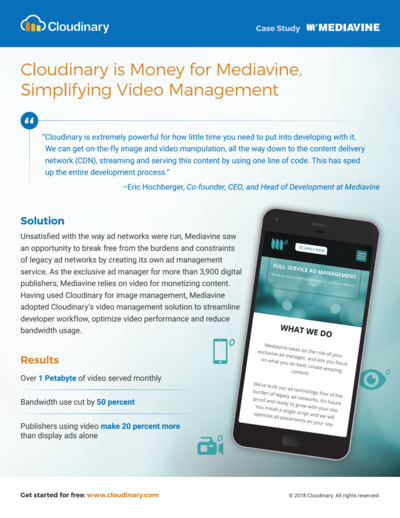A successful media publisher since 2004, Mediavine owns and runs popular sites like The Hollywood Gossip and Food Fanatic. In 2013, Mediavine expanded its service offerings to over 3,900 publishers to include ad optimization, video monetization, and influencer-marketing campaigns.
A long time Cloudinary customer for image-management, Mediavine turned to Cloudinary when it needed help with video. By utilizing Cloudinary, Mediavine was able to streamline video workflow, optimize video performance, and reduce bandwidth consumption. The impressive results speak for themselves:
- Mediavine now serves over 1 Petabyte of video monthly.
- Bandwidth usage has dropped by half.
- For Mediavine’s publishers, video is generating 20 percent more revenue than display ads.
Video is the fastest-growing revenue generator for Mediavine. To monetize content for publishers, Mediavine manages their preroll advertising.
However, ensuring all video content worked well was a complex, time-consuming process that was managed by third-party video players. Also, the initial video player Mediavine used was integrated with a competing video-ad server, further complicating the scenario. Getting off that player was critical.
| “Cloudinary had already made it so much easier for us to manage images, so the second the company said they could do the same for video, I knew Cloudinary was the obvious choice.” — Eric Hochberger, Cofounder, CEO, and head of development at Mediavine |
To start, Mediavine automated video uploads through the Cloudinary API, which had been integrated with the WordPress Mediavine plug-in used by publishers. Subsequently, with a single button click, publishers could add video to posts or grab embedded code from their Mediavine dashboard, signalling Mediavine to apply the appropriate predefined streaming profiles to the videos.
“We can get on-the-fly image and video manipulation, all the way down to the CDN [content delivery network], streaming and serving that content with only one line of code,” Hochberger continued.
With Cloudinary, Mediavine has saved numerous developer hours, particularly vis-a-vis codec rollouts. An example is the recent move to H.265 and VP9, with which Mediavine regenerated more than 30,000 videos in only one day.
Mediavine publishers who run both video and display ads typically see earnings rise by 20 to 30 percent. In addition, optimized video attracts more traffic to the publisher sites, raising their Google rankings.
“Adding video to my site has dramatically boosted its revenue potential and page views,” said Courtney O’Dell, a Mediavine publisher of the website Sweet C’s. “In a crowded web niche, it can be hard to stand out in search results or make a splash in social media. Videos have raised my site’s search ranking and kept viewers engaged and interested in its content. After adding videos with preroll ads to my site, I started making more money each month than the entire previous year.”
Separately, Mediavine’s move to H.265 and VP9 reduced its video-bandwidth usage by half with no quality loss whatsoever, simultaneously benefitting the viewers, too. It’s a win-win with Cloudinary.

